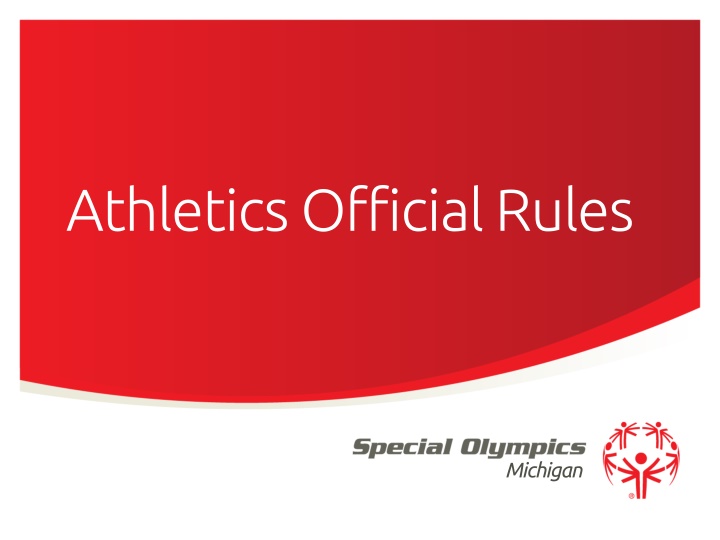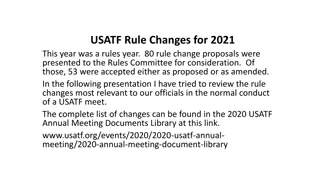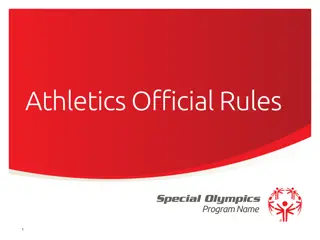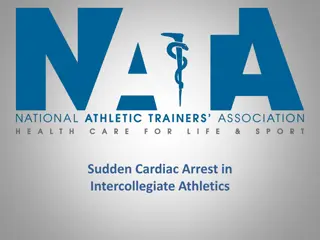
Michigan Athletics Official Rules and Event Guidelines
Explore the official rules and guidelines for various track and field events, wheelchair competitions, and developmental events in Michigan. Learn about uniform guidelines and the preferred attire for competitors. Discover the regulations regarding footwear, track spikes, and jewelry in athletic competitions.
Download Presentation

Please find below an Image/Link to download the presentation.
The content on the website is provided AS IS for your information and personal use only. It may not be sold, licensed, or shared on other websites without obtaining consent from the author. If you encounter any issues during the download, it is possible that the publisher has removed the file from their server.
You are allowed to download the files provided on this website for personal or commercial use, subject to the condition that they are used lawfully. All files are the property of their respective owners.
The content on the website is provided AS IS for your information and personal use only. It may not be sold, licensed, or shared on other websites without obtaining consent from the author.
E N D
Presentation Transcript
Athletics Official Rules Michigan
Track Events 50 M Dash 100 M Dash 200 M Dash 400 M Dash 800 M Run 1500 M Run 5000 M Run 4 x 100 M Relay
Field Events Standing Long Jump Running Long Jump Softball Throw Shot Put High Jump Mini Javelin
Pentathlon 100 M 400 M Running Long Jump High Jump Shot Put
Walking Events 100 M Walk 200 M Walk 400 M Walk 800 M Walk
Wheelchair Events Non-Motorized 25 M Wheelchair Race 50 M Wheelchair Race Slalom 30 M Slalom 4 x 25 M Wheelchair Relay Motorized 30 M Motorized Wheelchair Slalom 50 M Motorized Wheelchair Slalom 25 M Motorized Wheelchair Obstacle Race Field Events Wheelchair Shot Put
Developmental Events Walking Events 10 M Assisted Walk 25 M Assisted Walk 25 M Unassisted Walk 50 M Unassisted Walk Field Events Ball Throw (distance) Frisbee Wheelchair Events 10 M Wheelchair Race
Uniform Guidelines The preferred uniform is a tank-top type jersey and lightweight running shorts. In all events competitors must wear clothing that is clean, designed and worn so as not to be objectionable. Clothing must be made of material that is non-transparent even when wet. The competitors must not wear clothing that could impede the view of the judges.
Uniform Guidelines Competitors may compete bare footed or with proper athletic footwear on one or both feet. The purpose of shoes for competition is to give protection and stability to the feet and a firm grip on the ground. Such shoes, however, must not be constructed so as to give the competitor and additional assistance, and no spring or device or any kind may be incorporated in the shoes. A strap over the instep is permitted.
Uniform Guidelines Track spikes measuring no longer than can be used at Central Michigan University s track (although discouraged). Spikes not meeting this specification will be prohibited. Jewelry is prohibited.
Track Events In competition the commands of the Starter shall be on your marks, set, and when all the competitors are set, the gun shall be fired. In races 800 M or longer, the command shall be on your marks and when all competitors are steady, the gun shall be fired. A competitor shall not touch the ground with his/her hand(s). Starting races longer than 400 M: 800M distance-runner will run in the lanes through the first turn and break toward lane one at the break line marked after the first turn. 1500M and greater distances- A waterfall start shall be used.
Track Events All races up to and including the 100M shall be run on a straight away on a regular 400M track. All races up to the 100M shall be measured from the finish line. The start line will be adjusted for the various distances. All runners shall start from behind the start line. A runner completes the race when his/her torso reaches the perpendicular plane of the nearer edge of the finish line.
Track Events The starter shall give each competitor a chance to do his/her best by: Giving the competitors ample time to settle down after taking their marks. Starting the sequence over if any runner is off-balance. Not holding the runners too long after the set command. In relay events, runners must pass the baton within the exchange zone. Runners may not throw the baton to make a pass, and they must remain in their lanes throughout the 4x100 meter relay race. If there is a dropped baton, the athlete who dropped the baton must be the one to recover it.
Track Events One false start is allowed before disqualification. Runners will be disqualified for their second false start in a race. An athlete may not re-enter a race after exiting the race for any reason to continue competition.
Lane Violations In all races run in lanes, each competitor shall keep within his allocated lane from start to finish. If a competitor is pushed or forced by another person to run outside his lane, and if no material advantage is gained, the competitor should not be disqualified. If an athlete either: Runs outside his/her lane in the straight or runs outside the outer line of his lane on the bend, with no material advantage thereby being gained, and no other runner is obstructed, then the competitor should not be disqualified. Due to the possibility of low registration numbers, events age groups, and male and females may be combined. Athletes will be awarded separately.
Standing Long Jump Competitors shall start with both feet behind a designated take-off line and on the ground. A competitor shall use both feet on the take-off. He/she may rock backward and forward lifting his/her heels and toes alternately, but he/she may not lift either foot clear off the ground. Each competitor shall be allowed three non- consecutive jumps. The athlete s best jump will be used for scoring. All three jumps shall be measured and recorded for the purpose of breaking ties.
Standing Long Jump All distances will be measured along a perpendicular line from the foul line to the closest impression on the landing area made by any part of the athlete s body or clothing. Distance will be measured from the closest impression on the landing area made by a part of the body (including arms and hands) to the take-off line. Measurement will be taken in centimeters and meters. Exit pit from sides or rear. Walking back toward the runway, through your mark and crossing over the takeoff line will result in a foul For both standing and running long jump.
Running Long Jump The athlete must be able to jump at least one meter, which is the minimum distance between the toe board and the sand pit. Each competitor shall be allowed three non-consecutive jumps. The athlete s best jump will be used for scoring. All three jumps shall be measured and recorded for the purpose of breaking ties. All distances will be measured along a perpendicular line from the foul line to the closest impression on the landing area made by any part of the athlete s body or clothing. Measurement will be taken in centimeters and meters.
Running Long Jump Prior to competition, an athlete may receive assistance from an official to mark their runway starting point
Shot Put The shot may be steel, brass, or a synthetic-covered implement. The size of the shot used in competitor varies according to the divisions as follows: female athletes, age 8-11 will use 4#. Male athletes, aged 8-11 will use 6#. Female athletes, age 12 and up will use 6#. Male athletes age 12 and up will use 8#. A wheelchair athlete can use a 4# shot. The use of any mechanical aid shall not be allowed. For protective purposes only, the wrist, the hand, or as many as two adjoining fingers may be taped. There shall be no connecting tape between the fingers and the palm, fingers and the back of the hand, wrist and palm, wrist and the back of the hand, fingers and wrist, and the front and the back of the hand between fingers. The shot shall be put from the shoulder with one hand only. At the time the competitor takes a stance in the ring
Shot Put The shot may be steel, brass, or a synthetic-covered implement. The size of the shot used in competitor varies according to the divisions as follows: Females ages 8-11 will use a 4-pound shot. Male athletes ages 8-11 will use a 6-pound shot. Female athletes ages 12 and up will use 6-pound shot. Male athletes ages 12 and up will use an 8-pound shot. A wheelchair athlete will use a 4-pound shot.
Shot Put The use of any mechanical aid shall not be allowed. For protective purposes only, the wrist, the hand, or as many as two adjoining fingers may be taped. There shall be no connecting tape between the fingers and the palm, fingers and the back of the hand, wrist and palm, wrist and the back of the hand, fingers and wrist, and the front and the back of the hand between fingers. The shot shall be put from the shoulder with one hand only. At the time the competitor takes a stance in the ring to commence a put, the shot shall touch or be in close proximity to the chin, and the hand shall not be dropped below the position during the act of putting. The shot must not at any time be brought behind the line of the shoulders and thrown.
Shot Put A competitor must start from a stationary position inside the circle and must exit the back half of the circle upon the completion of the put. A legal put shall be made from within the circle, and the athlete, or his/her wheelchair, may not touch the top edge of the toe-board, the line of the circle, or any surface outside of the circle. It is legal to touch the inside of the toe board. Each competitor shall be allowed three non-consecutive throws. Measurement of each throw is required for the purpose of breaking ties. Enter and exit from the back or the throwing ring/circle or area. Measurement will be taken in centimeters and meters.
Shot Put The put shall be declared foul and shall not be measured if, after entering the circle and starting the put the competitor commits any of the following: Uses any method contrary to the definition of a legal put. Causes the shot to fall on or outside the lines marking the putting sections. Puts a shot, which does not conform to the legal requirements. Wears any illegal device or taping on the putting arm, wrist hand or fingers.
High Jump The competitor shall take off from one foot. The minimum opening height for all high jump competitions shall be 1m. Do not touch the pit, standards or bar, or cross the horizontal plane, when deciding not to jump after a bad approach. The approach can be restarted if the pit, bar or horizontal plane has not been touched and time remains.
High Jump Competitors shall not dive forward over the bar or take off from a two-footed takeoff. If, during warm up, any competitor performs a deliberate forward dive or two-footed takeoff, that competitor shall be disqualified from the high jump and receive a participation ribbon. If, during competition, any competitor performs a forward dive or two-foot takeoff, that competitor shall cease competition and be given the proper place from the last legally cleared height. If this occurs during the pentathlon, the competitor receives the points for the legally cleared height. Exit pit from the sides or rear.
Softball Throw Competitors may use any type of throw. All divisions age 12 and up shall use the standard size 12 softball. All 8 11-year-old age divisions may use a smaller size 11 softball. Each competitor shall be allowed three non- consecutive throws. The longest measurement of the three throws will be used for scoring. Throws will be measured from the inner edge of the arced throwing restraining line. Measurement of all throws is required for the purpose of breaking ties. Measurement will be taken in centimeters and meters. Enter and exit the back of the throwing ring/circle or area.
Mini-Javelin The nominal weights shall be: Men and Women ages 8-15: 300g Women ages 16 and over: 300g Men ages 16 and over: 400g The mini-javelin must be held by the grip with one hand only. The mini-javelin shall be thrown over the shoulder or upper part of the throwing arm and may be slung or hurled. At no time may the competitor turn completely around so that his/her back is toward the throwing area.
Mini-Javelin Athletes will make three nonconsecutive throws. Measurements will be taken from the throw line to the point the mini-javelin tip lands. Measurement will be taken in centimeters and meters. It is counted as a foul if the competitor: Does not use the proper throwing technique. Does not throw the mini-javelin so that the point (tip) lands before any other part of the implement. Does not throw the mini-javelin so that point (tip) falls completely within the inner edges of the sector lines.
Pentathlon The five events comprising the pentathlon shall be conducted in the following order: 100-meter dash Running Long Jump Shot Put High Jump 400-meter Dash It is recommended that the pentathlon be conducted in a two-day format with the first three events completed on the first day and the last two events completed on the second day.
Walking Events Walking and Wheelchair Events: In all race-walking events an athlete does not have to have a straight support leg while competing. In race walking events, up to and including the 800 meters, the competitor shall be disqualified with no prior warning when, in the opinion of two or more officials, an unfair advantage has been gained. Athletes must have one foot in touch with the ground at all times. The athlete will get two warnings before a third foul is called by three different officials to be disqualified.
Wheelchair Events Motorized wheelchairs shall not be allowed in regular wheelchair races. Only athletes who ambulate by use of wheelchair may participate in wheelchair events. Athletes shall not be pushed, pulled or otherwise assisted during these events. The lanes for the wheelchair events shall be made two track lanes wide.
20- 30- & 50-Meter Wheelchair Races Athletes entering wheelchair events may also enter other events within athletic competition. Competitors start with the first two wheels behind the start line. A competitor completes the race when the first two wheels cross the finish line. Each competitor must keep in his/her lane from start to finish and may not interfere, obstruct or impede the progress of another competitor. Infractions, at the discretion of the judges, may result in disqualification.
Wheelchair Slalom The slalom race shall consist of competitors maneuvering through cones placed every five meters along the distance of the course. Competitors must go in-between all cones or be disqualified. No penalty will be incurred by touching a cone. Coaches are not permitted to walk through the course with the athlete, they must stay in the designated area beyond the boundaries of the course.
Wheelchair Relay Four persons shall make up a team. Each competitor will compete 25 meters of the relay. The second, third, and fourth competitors of a team may not leave the start line until the leading wheel(s) on the wheelchair of the teammate who precedes him/her crosses a takeoff line one meter in front and parallel to the starting line. The fourth competitor completes the race when the first two wheels cross the finish line.
Motorized Wheelchair Events These events are restricted to motorized wheelchairs only. The first two wheels on each competitor s wheelchair will be regarded as the starting and finishing points of all races. If a competitor varies from a sequence of obstacles, he/she must, without notice from any official, resume progress at the point prior to the incorrectly-passed obstacle before entering the next obstacle and complete the course in its entirety; otherwise, he or she is disqualified. Failure to complete the course as designed will result in disqualification.
Motorized Wheelchair Events A competitor will be disqualified if that individual s coach enters the course boundaries during the running of the obstacle course. Coaches may instruct from outside the marked boundaries of the course. . Judges and officials will not give directional cues. All motorized wheelchairs shall be set on a high- speed setting.
25 Meter Motorized Wheelchair Obstacle Course Athlete starts facing the course. When inside or near the box, the athlete in the wheelchair completes a 360 degree circle. Athlete is not deducted any points or time for touching the lines on the box. The box is only an indicator for the athlete to do a complete circle with his/her wheelchair.
25 Meter Motorized Wheelchair Obstacle Course After the 360-degree circle is completed, the athlete should ambulate to the right of the first cone and then alternately weave in and out of the cones. After navigating the cones, the athlete enters the second turning box. Cones are set at three meters apart. Athlete completes a 360-degree circle near or within the box and then continues forward to the finish line.
25 Meter Motorized Wheelchair Obstacle Course The box is used only as an indicator for the athlete to complete a 360-degree circle between either the starting line and the first cone or the third cone and the finish line. The box can be outline with tape or chalk. There will be no penalties if an athlete strikes a cone or knocks over a cone. However, it is up to the official to determine that the athlete was making an honest effort to go around the cones and not drive over the cones in a straight-line pattern. If it is determined that the athlete drove his/her wheelchair over the cone without an effort to go around, that athlete shall be disqualified.
Developmental Walking Events This race is designed for those athletes who require the use of a walking aid only. Those not requiring the use of a walking aid should register for the 25- or 50- Meter unassisted walk. Athlete starts behind the start line with a walking aid. Athlete begins race at the sound of the starter s gun or whistle. Athlete walks the ten meters using a walking aid. Athletes must stay in his/her designated lane. Athlete may not receive assistance from coaches, officials, etc.
Unassisted Walks For the 25- and 50- Meter unassisted walks rules are the same as the 10- and 25-Meter assisted walks, but the athlete does not use a walking aid during the race.
10 Meter Wheelchair Event Athlete starts with all wheels of wheelchair behind the start line and facing the designated lane. Athlete begins racing at the sound of the starter s gun. Athlete must stay in his/her designated lane. The first two wheels must cross the plane of the finish line to receive an official time.
Ball Throw for Distance Athletes use a tennis ball and throw as far as they can. Athletes can use any type of throw. Athletes are allowed three non-consecutive throws. The longest measurement of the three throws will be used for scoring. Throws will be measured from the inner edge of the arced throwing restraining line. Measurement of all throws is required for the purpose of breaking ties. Measurements are taken in meters and centimeters.
Frisbee Throw for Distance The venue set-up for Frisbee Throw is the same as for Softball Throw. Athletes use a Frisbee and throw as far as they can. Athletes can use any type of throw. Athletes are allowed three consecutive throws. The longest measurement will be used for scoring. Throws will be measured from the inner edge of the arced throwing restraining line. Measurement of all throws is required for the purpose of breaking ties. Measurements are taken in meters and centimeters.
Terms Anchor Leg: The final or fourth leg of the race Approach: The run-up made by an athlete before performing a skill, i.e. long jumping Closed Position: A powerful throwing back position for the shot put in which the putting shoulder and hip are back Did Not Finish (DNF): When an athlete starts a race, but drops out before crossing the finish line. Disqualification (DQ): When an athlete violates a rule, does not show up, or gains an unfair advantage by impeding or interfering.
Terms False Start: Leaving the starting blocks before the start command. Heat: A grouping of athletes for competition Impeding: A violation in which one runner bumps, or cuts in front of, another runner, forcing him to slow down or break stride Pace: The rate of covering a specific distance while running or walking Power Foot: The lead foot in a race; preferred or strength foot
Terms Scratch Line: The restraining line which cannot be crossed in throwing and jumping events Shot Put: Iron, plastic or brass spheres used for shot put competition Swing: Pendulum action of an athlete s body or parts of the body Warm-up: The gradual process of raising the body temperature and loosening muscles prior to strenuous exercise Weight Training: Development of strength with the use of weight lifting and based on the overload principle






















